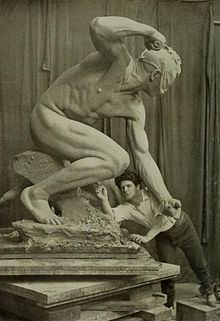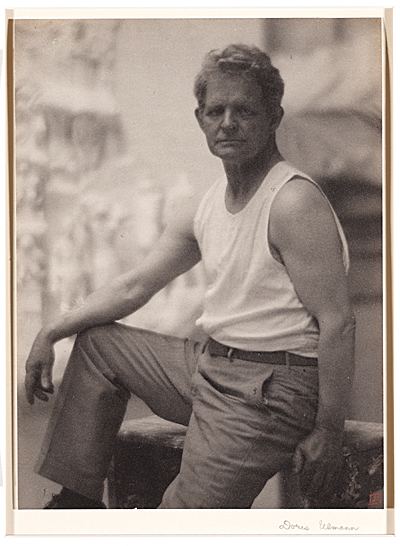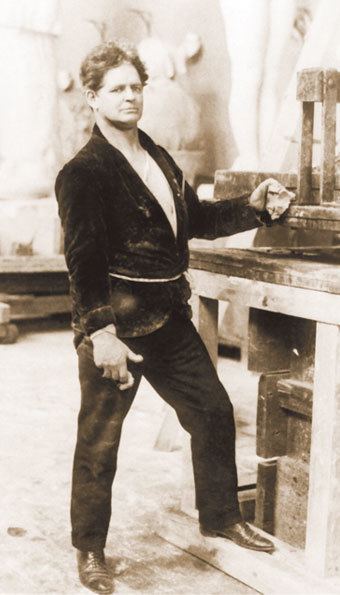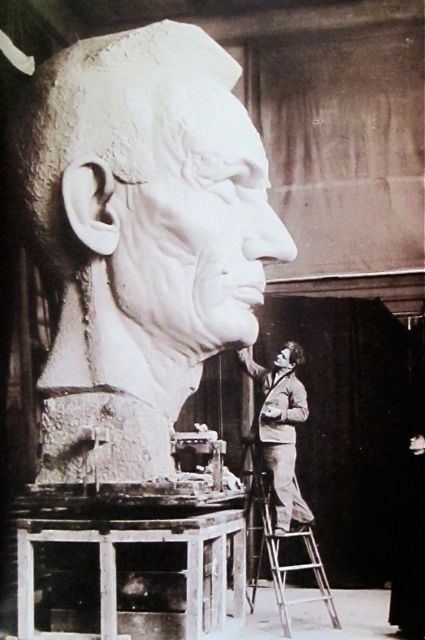Nationality American Name George Barnard | ||
 | ||
Education School of the Art Institute of Chicago | ||
George Grey Barnard (May 24, 1863 – April 24, 1938), often written George Gray Barnard, was an American sculptor who trained in Paris. He is especially noted for his heroic sized Struggle of the Two Natures in Man at the Metropolitan Museum of Art, his twin sculpture groups at the Pennsylvania State Capitol, and his Lincoln statue in Cincinnati, Ohio. His major works are largely symbolical in character. His personal collection of Medieval architectural fragments forms a core part of The Cloisters in New York City.
Contents
- Biography
- 1913 Assessment by Lorado Taft
- Selected works
- Pennsylvania State Capitol sculpture groups
- Legacy
- References

Biography

Barnard was born in Bellefonte, Pennsylvania, but grew up in Kankakee, Illinois, the son of Reverend Joseph Barnard and Martha Grubb, and the grandson and namesake of merchant George Grey Grubb. He first studied at the Art Institute of Chicago under Leonard Volk. He attended the École nationale supérieure des Beaux-Arts in Paris, 1883–1887, while working in the atelier of Pierre-Jules Cavelier. He lived in Paris for twelve years, and scored a great success with his first exhibit at the Salon of 1894. He returned to America in 1896, and married Edna Monroe of Boston. He taught at the Art Students League of New York from 1900 to 1903, succeeding Augustus Saint-Gaudens. He returned to France, and spent the next eight years working on his sculpture groups for the Pennsylvania State Capitol. He was elected an associate member of the National Academy of Design in 189x, and an academician in 1902.

A strong Rodin influence is evident in his early work. His principal works include the allegorical "Struggle of the Two Natures in Man" (1894, in the Metropolitan Museum, New York); "The Hewer" (1902, at Cairo, Illinois); "Great God Pan" (1899, at Columbia University); the "Rose Maiden" (c.1902, at Muscatine, Iowa); the simple and graceful "Maidenhood" (1896, at Brookgreen Gardens).

In 1911 he completed two large sculpture groups for the new Pennsylvania State Capitol: The Burden of Life: The Broken Law and Love and Labor: The Unbroken Law. Between the two groups, they feature 27 larger-than-life figures.

His larger than life-sized statue of Abraham Lincoln (1917), was the subject of heated controversy because of its rough-hewn features and slouching stance. The first casting is at Lytle Park in Cincinnati, Ohio (Abraham Lincoln (George Grey Barnard), 1917), the second in Manchester, England (1919), and the third in Louisville, Kentucky (1922).

The Great God Pan (1907), one of the first works Barnard completed after his return to America, according to at least one account, was originally intended for the Dakota Apartments on Central Park West. Alfred Corning Clark, builder of the Dakota, had financed Barnard's early career; when Clark died in 1896, the Clark family presented Barnard's Two Natures to the Metropolitan Museum of Art in his memory, and the giant bronze Pan was presented to Columbia University, by Clark's son, Edward Severin Clark.
French art dealer René Gimpel described him in his diary (1923), as "an excellent American sculptor" who is "very much engrossed in carving himself a fortune out of the trade in works of art." Barnard had a commanding personal manner: "He talks of art as if it were a cabalistic science of which he is the only astrologer", wrote the unsympathetic Gimpel; "he speaks to impress. He's a sort of Rasputin of criticism. The Rockefellers are his imperial family. And the dealers court him."
Interested in medieval art, Barnard gathered discarded fragments of medieval architecture from French villages before World War I. He established this collection in a church-like brick building near his home in Washington Heights, Manhattan in New York City. The collection was purchased by John D. Rockefeller Jr. in 1925 and forms part of the nucleus of The Cloisters collection, part of the Metropolitan Museum of Art.
Barnard died following a heart attack on April 24, 1938 at the Harkness Pavilion, Columbia University Medical Center in New York. He was working on a statue of Abel, betrayed by his brother Cain, when he fell ill. He is interred at Harrisburg Cemetery in Harrisburg, Pennsylvania.
1913 Assessment by Lorado Taft
George Grey Barnard is a Westerner, although he chanced to be born in Pennsylvania, where his parents were temporarily residing in 1863. The sculptor’s father is a clergyman, and the fortunes of the ministry afterward led him to Chicago, and thence to Muscatine, Iowa, where the son passed his boyhood. One cannot doubt that these circumstances had their profound influence upon the character of the young artist. In it is something of the largeness of the western prairies, something of the audacity of a life without tradition or precedent, a burning intensity of enthusiasm; above all, a strong element of mysticism which permeates all that Barnard does or thinks.
The stories of his student struggles in Chicago and Paris are familiar. The first result of all this self sacrifice became tangible in that early group, a tombstone for Norway, in which the youth portrayed “Brotherly Love,” a work of “weird and indescribable charm.”
In 1894 Barnard completed his celebrated group, “Two Natures,” upon which he had toiled, in clay and marble, for several years. This masterful achievement gave him at once high standing in Europe, and his work has never since ceased to interest the cultivated public of the world’s capitals. Then followed an extraordinary “Norwegian Stove,” a monumental affair illustrative of Scandinavian mythology; and “Maidenhood” and the “Hewer,” two of the finest nudes thus far produced in America.
Selected works
Pennsylvania State Capitol sculpture groups
Legacy
.
